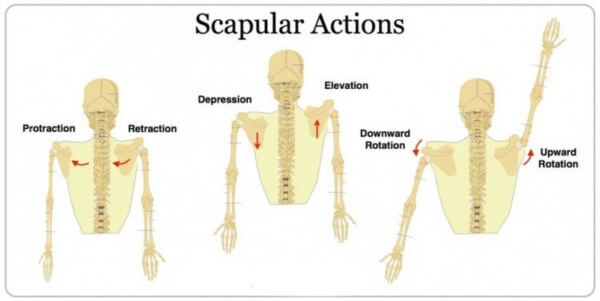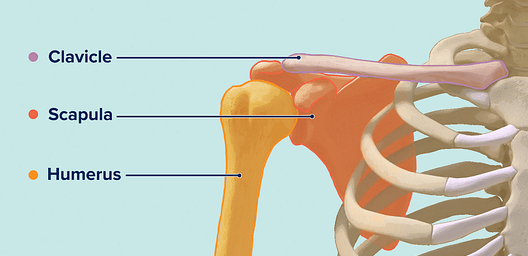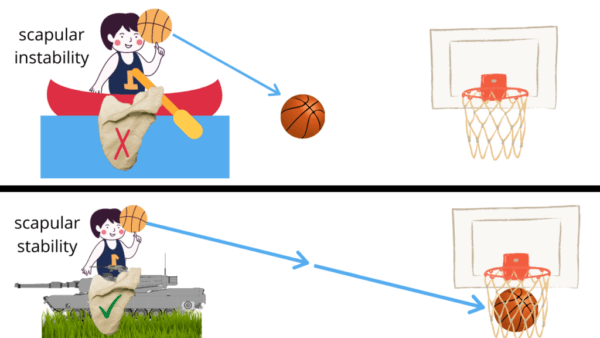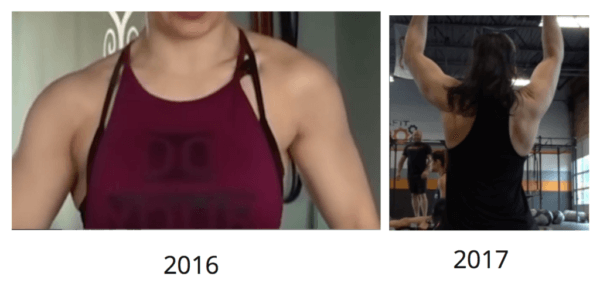Welcome to unit 27!
Last unit, I introduced hanging leg raises. This requires the ability to maintain your shoulder blades set (i.e. your lats engaged) while hanging with your arms straight. So let's spice things up and make sure you can keep your lats engaged when moving between scapular depression and elevation with your arms straight in an overhead position. This is actually not an easy movement pattern to execute. Think about it: when have you ever strengthened this pattern in your daily movements? For instance, when you reach for an apple high up in a tree, you intuitively shrug up using the upper traps/levator scap to make yourself "taller"... the last thing you think of is... "ooooh let me engage my lat and set my shoulder blade so I won't become upper trap dominant".
Scapular depression (with the lats engaged) is indeed a prerequisite for pull-ups, and even for sandbag carries.
Scapular elevation (with the lats engaged) is indeed a prerequisite for handstands and overhead pressing.
Scapular Pull-Ups are a great way to train the lats to stay engaged while moving between scapular elevation and depression!
______________________________________________________________________
The Role of the Scapula
The scapulae (shoulder blades) have a very important role in upper extremity function. The scapulae provide a stable base from which glenohumeral (shoulder) mobility occurs.
Scapular instability alters your shoulder biomechanics in a bad way. It can cause a lot of stress on the anterior shoulder capsule, increase the chances of rotator cuff impingement (upper trap dominance), and decrease shoulder mobility.
Here is a photo of the 6 scapular movements. Note that regardless of the scapular movement, your lats must be engaged! Lat engagement is like wearing a seatbelt for your shoulder girdle... it protects you from shoulder injury. Most of us have not trained the ability to stabilize with the lats in all of these positions... so that's the purpose of the academy ... to bring awareness to this so you will know what you need to work on!


What is scapular instability? Pretend your scapula is a canoe in the water, and you are standing in the canoe. You represent the arm. So, scapular instability would be like throwing a basketball into a basketball hoop while standing in a canoe. Since the canoe is unstable, your arm will be difficult to control and the basketball will probably not go where you had intended (in the hoop). Basically, you want your scapula to be like a giant army tank that is parked on the ground (a super stable base). That way, when you throw the ball, it will go in the hoop. I made this analogy up and was laughing out loud creating this graphic!!!!

When there is a weakness or deficiency of the scapular musculature, it alters normal scapular positioning and mechanics. Take a look at this photo to understand this concept. As you can see, I had left scapular instability: look at the altered left scapular positioning and mechanics. I clearly had left upper trap dominance. I lucked out and didn't have rotator cuff impingement, but I had left thoracic outlet syndrome (tingling in my fingers).

When the scapula fails to perform its stabilization role, the shoulder complex function is inefficient. This can result in decreased neuromuscular performance and injury of the glenohumeral joint.
Conclusion: Scapular stability makes your shoulders nearly bulletproof, and this makes it possible for you to learn how to do really cool things with your body! The stronger your foundation is at stabilizing you in space (Structure, Stability), the more success you will have at building strength and mobility (Specialty). That dang S-pyramid just keeps showing up! I'll talk about the S-pyramid in an upcoming week! Stay tuned.
If you look up "scapular stabilizers", this will be the answer: the serratus anterior, rhomboids, levator scapulae, and traps. No one ever mentions the lats, but I sure do! Here's why:
In most people, the latissimus dorsi actually DOES attach to the inferior angle of the scapula! Pouliart et al investigated the anatomy of latissimus dorsi in 100 cadavers and found that in many specimens there was a connection to the scapula. The majority of people (79%) had either direct or indirect attachment to the inferior border of the scapula, while the remaining 21% had no attachment at all. So for most people, the lats assist the rhomboids in retraction of the scapula (pulling the shoulder blades back and together). Pouliart, N., & Gagey, O. (2005). Clinical Anatomy, 18(7), 493–499.
The concentric action of the lats is shoulder extension (think lat pulldown). BUT, everyone overlooks the ECCENTRIC role of the lats with overhead pressing. When you extend your arms overhead, your lats are lengthening, which means they CONTROL shoulder flexion. Unless you can activate your lats, then you won't be able to maintain tension in your lats as you extend your arms overhead. The goal is to be able to maintain tension in your lats throughout the full 180 degrees of shoulder range of motion as you raise your arms overhead. So if one of your lats is weak or not firing, this can interfere with overhead pressing, handstands, and even getting into the starting position of a pull-up.
You may have noticed that the Strength Academy is focusing on strengthening the larger muscles that attach to your shoulder blades, particularly the serratus anterior, latissimus dorsi, rhomboids, and the middle/lower trapezius muscles. Think of these muscles as the "core" of the shoulders. We can nickname it "the shoulder core".
This week, we are going to work on:
- improving your ability to isolate the feeling in your TVA
- scapular stability
______________________________________________________________________
UNIT 27 EXERCISES:
Banded L-Sit Prep
It's all about creating a network of feelings.
How do you improve your ability to isolate the feeling in your TVA? By identifying the key feelings you are trying to create in your body during the L-sit. This means paying close attention to the feelings you get when you do:
- L-Sit Prep (digging deeply into the TVA) ... using a band will really help you dig deep and get your hips way back.
- Pushing into the ground (digging deeply into scapular depression). Get angry at the ground... push hard! Apply the expansion theory!
Banded Snow Angels - Follow Along Routine 6min
I couldn't think of a name for these. So I'm calling them "banded snow angles".
You want the thoracic spine doing the extending (so that means stabilizing the lumbar spine with your TVA).
Keep both arms straight (apply the expansion theory) and keep both lats engaged the entire time (as stabilizers) so that your shoulders are stabilized. Watch yourself in a mirror for biofeedback. You can do these seated or in stance.
Work with the ranges you have: you may not be able to hold the band vertically overhead. It's ok if you hold it a bit forward of vertical (like how you overhead press a sandbag a bit forward). Over time, you'll open up more.
In the overhead position, you elevate the shoulder blades (just like you do in a handstand)... however, the lats are engaged, which is why this is NOT an upper trap dominant movement. Don't be scared of scapular elevation... it's only scary if you do it without your lats engaged. I like that the resistance band reminds us to keep our lats engaged!
Tip: think of applying the expansion theory at the shoulder joints and t-spine ... this will help you open up more.
Unilateral Scapular Pull-Downs
Keep your arm straight. Don't cheat by contorting your torso. Make sure the cable or band is pulled down by the scapula depressing. Isometric holds of the depressed position are always a good idea! I should you how to scale this by changing where you sit relative to the overhead cable/band.
Hanging Scapular Pull-Ups
I updated this video by editing it (shortening it) and adding my notes below. It was not necessary for me to film a new demo.
What are hanging scapular pull-ups? You basically move from scapular elevation to scapular depression, but you do it hanging with straight arms from a bar.
What is the most important thing to takeaway? Make sure your lats are engaged (as stabilizers) the entire time you move! How do you engage your lats in an overhead position? By applying an inward energy, as if you are going to crush your head between your upper arms. You'll feel your lats tightly hug your rib cage (like a tight wool sweater) when you apply this inward energy.
I show beginner, intermediate and advanced versions. I even show unilateral variations (scaled options too!).
Work within your current range. What is your current range? it's where you can move while keeping both lats engaged. So you may not have a ton of end range scapular depression or elevation (yet)... which would make sense if this is unchartered territory for you. Please don't compensate your way into end-ranges.
Key Points: Keep your arms straight. Always apply an inward energy to keep your lats engaged as stabilizers.
Play with unilateral variations and isometric holds... this will help you find the feelings. Playing is so underrated. Playing is a fun way to learn.
Don't death grip the bar (this will actually disengage your lats).
______________________________________________________________________
UNIT 27 TRAINING PLAN:
Day 1: Sequence #34
Day 2: Sequence #29 (unit 23)
Day 3: Rest
Day 4: Sequence #35
Day 5: Rest
Day 6: Sequence #34 or 35 (you decide)
Day 7: Rest or review exercises from previous sequences that you know you need to revisit or do a sandbag carry.
Sequence 34: Overhead Extravaganza!
- Banded L-Sit Prep or L-Sit: hold 30s (or as long as you can), 5x
- Banded Snow Angels: do the routine with me.
- Unilateral Scapular Pull-Downs: 3 sets of 10 per arm
- Hanging Scapular Pull-Ups (you can do scaled or hanging versions). For all of these: do them in slow/controlled manner and for the last rep, include a 3-5s isometric holds when maximally depressed. If these aren't available to you yet, then work on the hanging holds from unit 6 & the stick pulls from unit 3.
-
- Do 5 reps bilaterally pronated grip.
- Do 5 reps bilaterally supinated grip.
- Do 5 unilateral reps L side (pronated). Either use the strap or decrease your grip with one hand. Scale with yoga block as needed.
- Do 5 unilateral reps R side (pronated). Either use the strap or decrease your grip with one hand. Scale with yoga block as needed.
- Repeat 1 thru 4 two more times!
- Finale: Bilateral Hanging hold until failure. Make sure your shoulder blades are depressed. Advanced folks can do the single arm version.
-
- Single Leg Wall Crow - 3 sets each side: hold for 15-30s. (unit 19). Scaling option: Dog Push-Ups 3 sets of 5 controlled reps. Hold the bottom of the push-up for 1-3 seconds (unit 2)
- Ball Press Hold - 6x. Pull your hips up as high as you can and hold until failure (ultimate goal is 30s). (unit 17). Scaling option: Blanket Slides - 5 sets of 8 to 15 reps (unit 5)
Sequence 35: Back Attack
- Banded L-Sit Prep or L-Sit: hold 30s (or as long as you can), 5x
- Bow & Arrow: do it 3 times per side until you cramp (unit 21)
- Teres Major Row Holds: (unit 7)
-
- Hold the end range row for 20s per arm.
- Then do 3 sets of 10 rows per arm.
-
- Lat Row Holds: (unit 7)
-
- Hold the end range row for 20s per arm.
- Then do 3 sets of 10 rows per arm.
-
- Prone ITY's routine: do the real time routine (unit 13)
- Chin-Over-Bar Hold (2 supinated, 2 pronated) + Slow Eccentric: Scale as necessary. (unit 13)
- Crow - 5 attempts, hold as long as you can. If you need to, scale with a yoga block under your forehead (unit 22).
- Tripod Headstand: Play for 5-10 minutes (unit 18) ..... or..... 3 sets of ME rope pulls until failure (unit 26)
_______________________________________________________________________________
HOMEWORK:
On day 7, post your hanging scapular pull-ups.
